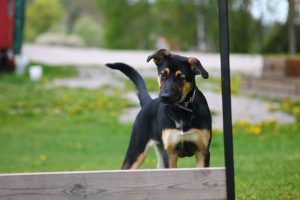 Want to train your dog to do a new trick or two? Agility is the fastest-growing dog sport in North America, and tests both dog and handler’s skills and fitness. Warren Eckstein talks about how to agility-train your dog.
Want to train your dog to do a new trick or two? Agility is the fastest-growing dog sport in North America, and tests both dog and handler’s skills and fitness. Warren Eckstein talks about how to agility-train your dog.
Information for this article is compiled from Warren Eckstein’s book “How to Get Your Dog to Do What You Want : A Loving Approach to Unleashing Your Dog’s Astonishing Potential.”
AGILITY IS ORIGINALLY based on equestrian stadium jumpers’ competitions, and made its debut as an entertainment for spectators at the Crufts Dog Show in 1979. It has since become the most rapidly growing dog sport in England, Western Europe, and North America.
The purpose of agility is to demonstrate the ability of the dog and its handler to work as a smoothly functioning team while negotiating over/under/through various obstacles and jumps. Dogs are directed through a series of obstacles and must complete the course in the allotted time. The dog should be under control at all times and show a willingness to work with the handler.
In the United States there are several national organizations for agility which sanction tests or trials held by local dog training clubs. In competition, the obstacles are arranged in various configurations which are unique from trial to trial. As the dog and handler earn their way into successively higher levels, the courses increase in complexity.
Dogs compete only against dogs of similar height within a fixed number of jump height divisions. The dog with the lowest number of faults and the fastest time wins the class or height division.
ELIGIBILITY FOR ENTRY
Generally, healthy, trained dogs over eighteen months of age are eligible to compete and most competitions are open to purebred and mixed breed dogs.
The Regular Agility class is the basis for all of the agility classes. This course tests the dog on all possible types of equipment and qualifying in this class demonstrates the dog’s ability to perform all of the types of obstacles safely and correctly. The dog and handler maneuver through a numbered obstacle course, designed by the judge. As the dog and handler progress through the levels of the Regular Agility classes, they demonstrate the ability to negotiate more complex courses with adequate speed, efficiency, handling skills, and teamwork on all obstacles.
Various types of obstacles can be included in the course. Our course, set up on the plaza in New York’s Rockefeller Center, includes the following:
Contact obstacles
8-foot dog walk: Dogs go up one side, across a thin wooden plank, and down the opposite side.
Tunnel obstacles
Closed tunnel: like an open-ended nylon sock, dog runs in one end, and shoots out the other.
Open tunnel: A long plastic, flexible tube.
Jumping obstacles
Displaceable tire jump: A suspended tire.
Long jump: Just like it sounds.
Hurdles: Can vary in height and width.
Dogs and trainers get a limited time to “practice” on the course, and usually are allowed to run through it only once or twice. While the obstacles are the same from competition to competition, the order and complexity of the route varies widely.
For a clean, non-faulted run the dog earns 10 points. Points are deducted for faults like running over the course time, knocking poles off jumps and running the course the wrong way. To be certified at a certain level and move up to higher ranks, the dogs need a total of 30 points.
In all agility classes, the handlers direct their dogs through the course without a collar or lead and without using food, toys, balls or other devices. However, the handler is allowed to use verbal or visual commands to assist the dog throughout the course.
HOW DO YOU TRAIN THEM FOR THESE TYPES OF THINGS?
Practice, practice, practice! Plus keeping it fun. Since each obstacle requires different skills, the dogs are trained differently for each one. For example, a ball can be thrown through the tunnels to “lure” them through (which, of course, can’t be done in competition) or treats can be used to help them over the see-saw and dog walks. But in every case, the handler makes it FUN for the dog, and in the end, they are rewarded with lots of positive petting!
WHAT DOES THE DOG GET OUT OF THIS?
Not only do they get in great shape, but they also learn to socialize well with other animals and people and get comfortable in different places.
WHAT KINDS OF DOGS ARE ALLOWED TO DO THIS?
All kinds! Big, small, pure-breeds, mixed-breeds… all can be included, and they compete against dogs that are approximately the same size (so that the jumps can be tailored for the course.) Personality-wise, the dogs must be responsive to commands, be willing to learn new obstacles, and full of energy.


